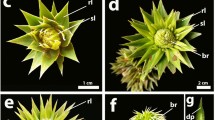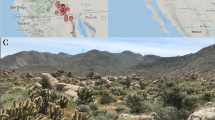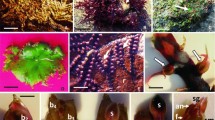Summary
Reproductive structures of both genders of Wollemia nobilis were investigated, including both wild-type and teratological cones. Typically, both pollen cones and seed cones in this species are terminal on first order branches. At maturity, wild-type pollen cones are pendulous and cylindrical; wild-type seed cones are broad and ellipsoidal in shape. The teratological structures consisted of a basal region that resembled a typical fertile seed cone, and an apical proliferation that terminated in a well-developed pollen cone, resulting in a ‘bisexual’ unit. The proximal seed cone and the distal pollen cone were separated by a sterile region that represents an elongation of the cone axis. Of a total of 14 anomalous bisexual units investigated, all had the same bauplan. Such an arrangement of basal ovulate and distal staminate reproductive structures in a teratological conifer cone has previously not been reported for Wollemia. This topology is 'inside-out' with respect to most other reported anomalous bisexual conifer cones, which possess proximal staminate and distal ovulate structures. We discuss these spontaneous abnormalities in the broader context of understanding the homologies of seed-plant reproductive structures. The patterning of conifer cones is apparently highly labile, perhaps related to the extended cone axis and relatively long developmental duration.


Similar content being viewed by others
References
Bateman, R. M., Hilton, J. & Rudall, P. J. (2006). Morphological and molecular phylogenetic context of the angiosperms: contrasting the ´top-down´ and ´bottom-up´ approaches to inferring the likely characteristics of the first flowers. J. Exp. Bot. 57: 3471 – 3503.
Bateman, R. M.____ & Rudall, P. J. (2006). The Good, the Bad and the Ugly: using spontaneous terata to distinguish the possible from the impossible in orchid floral evolution. Aliso 22: 481 – 496.
Bateman, R. M.____Rudall, P. J., ____ & Hilton, J. (2011). Spatial separation and developmental divergence of male and female reproductive units in gymnosperms, and their relevance to the origin of the angiosperm flower. In: L. Wanntorp & L. P. Ronse DeCraene (eds), Flowers on the tree of life, pp. 8 – 48. Cambridge University Press, Cambridge.
Carlsbecker, A., Sundström, J. F., Englund, M., Uddenberg, D., Izquierdo, L., Kvarnheden, A., Vergara-Silva, F. & Engström, P. (2013). Molecular control of normal and acrocona mutant seed cone development in Norway spruce (Picea abies) and the evolution of conifer ovule-bearing organs. New Phytol. 200: 261 – 275.
Coen, E. S. & Meyerowitz, E. M. (1991). The war of the whorls: genetic interactions controlling flower development. Nature 353: 31 – 37.
Caron, G. E. & Powell, G. R. (1991). Proliferated seed cones and pollen cones in young black spruce. Trees 5: 65 – 74.
Chambers, T. C., Drinnan, A. N. & McLoughlin, S. (1998). Some morphological features of Wollemi pine (Wollemia nobilis: Araucariaceae) and their comparison to Cretaceous plant fossils. Int. J. Pl. Sci. 159: 160 – 171.
Coulter, J. M. & Chamberlain, C. J. (1917). Morphology of Gymnosperms, 2nd ed. University of Chicago Press, Chicago.
Dörken, V. M. (2011). Proliferating seed cones in Metasequoia glyptostroboides Hu & Cheng (Cupressaceae s.l., Coniferales) elucidate the evolution of seed cones and ovules in Cupressaceae s.l. Feddes Repert. 122: 409 – 420.
Dörken, V. M.____ (2017). Pollen cone anomalies in Pinus sylvestris and Tsuga canadensis (Pinaceae): can they give new insights in the evolution of microsporangiophores in conifers? Bull. Cupressus Conservation Proj. 6: 30 – 40.
Dörken, V. M.____ & Jagel, A. (2014). Orientation and withdrawal of pollination drops in the Cupressaceae s. l. (Coniferales). Flora 209: 34 – 44.
Dörken, V. M.____ & Nimsch, H. (2016). Some new aspects about the evolution of pollen cones and perisporangiate microsporangiophores in Taxaceae. Bull. Cupressus Conservation Proj. 5: 3 – 21.
Dörken, V. M.Nimsch, H.____, ____ & Jagel, A. (2017). Morphology, anatomy and morphogenesis of seed cones of Cupressus vietnamensis (Cupressaceae) and its taxonomic and systematic implications. Flora 230: 47 – 56.
Dörken, V. M.Nimsch, H.____ & Rozynek, B. (2013). Proliferated megasporangiate strobili of Zamia furfuracea (Zamiaceae, Cycadales) and its possible evolutionary implications for the origin of cycad megasporophylls. Palaeodiv. 6: 135 – 147.
Dörken, V. M.Nimsch, H.____ & KLK;Rudall, P. J. (2018). Understanding the cone scale in Cupressaceae: insights from seed-cone teratology in Glyptostrobus pensilis. PeerJ 2018: e4948.
Dörken, V. M.Nimsch, H.____ & Stützel, T. (2011a). Pflanzliche Missbildungen und deren Interpretation am Beispiel von Sciadopitys verticillata Siebold & Zucc. (Sciadopityaceae) mit intermediär gestalteten Kladodien. Mitt. Deutsch. Dendrol. Ges. 96: 125 – 149.
Dörken, V. M.Nimsch, H.____ & Stützel, T.____ (2011b). Morphology and anatomy of anomalous cladodes in Sciadopitys verticillata Siebold & Zucc. (Sciadopityaceae). Trees (2011) 25: 199 − 213.
Dörken, V. M.Nimsch, H.____, Zhang, Z. X., Mundry, I. B. & Stützel, T. (2011). Morphology and anatomy of male reproductive structures in Pseudotaxus chienii (W.C. Cheng) W.C. Cheng (Taxaceae). Flora 206: 444 – 450.
Eckenwalder, J. E. (2009). Conifers of the world. Timber Press, Portland.
Escapa, I. H. & Catalano, S. A. (2013). Phylogenetic analysis of Araucariaceae: integrating molecules, morphology, and fossils. Int. J. Plant Sci. 174: 1153 – 1170.
Farjon, A. (2008). A natural history of conifers. Timber Press, Portland.
Farjon, A.____ (2010). A handbook of the world’s conifers, Vol. I & II. Brill, Leiden.
Farjon, A.____ & Garcia, S. O. (2003). Cone and ovule development in Cunninghamia and Taiwania (Cupressaceae sensu lato) and its significance for conifer evolution. Amer. J. Bot. 90: 8 – 16.
Florin, R. (1951). Evolution in cordaites and conifers. Acta Horti Bergiani 17: 7 – 37.
Florin, R.____ (1954). The female reproductive organs of conifers and taxads. Biol. Rev. 29: 367 – 389.
Gadek, A. P., Alpers, D., Heslewood, M. M. & Quinn, C. J. (2000). Relationships within Cupressaceae sensu lato: a combined morphological and molecular approach. Amer. J. Bot. 87: 1044 – 1057.
Gerlach, D. (1984). Botanische Mikrotomtechnik, eine Einführung, 2nd ed. Thieme, Stuttgart.
Gerstberger, P. & Leins, P. (1978). Rasterelektronenmikroskopische Untersuchungen an Blütenknospen von Physalis philadelphia (Solanaceae). Ber. Deutsch. Bot. Ges. 91: 381 – 387.
Gilmore, S. & Hill, K. D. (1997). Relationships of the Wollemi Pine (Wollemia nobilis) and a molecular phylogeny of the Araucariaceae. Telopea 7: 275 – 291.
Groth, E., Tandre, K., Engström, P. & Vergara-Silva, F. (2013). AGAMOUS subfamily MADS-box genes and the evolution of seed cone morphology in Cupressaceae and Taxodiaceae. Evol. Dev. 13: 159 – 170.
Jagel, A. (2002). Morphologische und morphogenetische Untersuchungen zur Systematik und Evolution der Cupressaceae s.l. (Zypressengewächse). PhD-thesis, Ruhr-University Bochum.
Jagel, A.____ & Dörken, V. M. (2014). Morphology and morphogenesis of the seed cones of the Cupressaceae, I: Cunninghamioideae, Athrotaxioideae, Taiwanioideae, Sequoioideae, Taxodioideae. Bull. Cupressus Conservation Proj. 3: 99 – 121.
Jagel, A.____& Dörken, V. M.____ (2015a). Morphology and morphogenesis of the seed cones of the Cupressaceae, II Cupressoideae. Bull. Cupressus Conservation Proj. 4: 51 – 78.
Jagel, A.____ & Dörken, V. M.____ (2015b). Morphology and morphogenesis of the seed cones of the Cupressaceae, III Callitroideae. Bull. Cupressus Conservation Proj. 4: 91 – 108.
Jagel, A.Dörken, V. M.____ & Stützel, T. (2001). Zur Abgrenzung von Chamaecyparis Spach und Cupressus L. (Cupressaceae) und die systematische Stellung von Cupressus nootkatensis D. Don [= Chamaecyparis nootkatensis (D. Don) Spach]. Feddes Repert. 112: 179 – 229.
Jagel, A.Dörken, V. M.____ & Stützel, T.____ (2003). On the occurrence of non-axillary ovules in Tetraclinis articulata (Vahl) Mast. (Cupressaceae s.str.). Feddes Repert. 114: 497 – 507.
Jones, W. G., Hill, K. D. & Allen, J. M. (1995). Wollemia nobilis, a new living Australian genus in the Araucariaceae. Telopea 6: 173 – 176.
Kunzmann, L., Mohr, B. A. R. & Bernardes-de-Oliveira, M. E. C. (2004). Gymnosperms from the Lower Cretaceous Crato Formation (Brazil). I. Araucariaceae and Lindleycladus (incertae sedis). Mitt. Mus. Nat.kd. Berl., Geowiss Reihe 7: 155 – 174.
Lanner, R. M. (1966). An unusual bisexual Agathis cone. Pacific Sci. 20: 282 – 283.
Lemoine-Sebastian, C. (1967). Appareil reproducteur male de Juniperus. Trav. Lab. Forest. Toulouse 1: 1 – 35.
Masters, M. T. (1869). Vegetable Teratology. Ray Society, London.
McLoughlin, S. & Vajda, V. (2005). Ancient wollemi pines resurgent. Amer. Sci. 93: 540 – 547.
Moyroud, E., Kusters, E., Monniaux, M., Koes, R. & Parcy, F. (2010). LEAFY blossoms. Trends Pl. Sci. 15: 346 – 352.
Moyroud, E.____, Monniaux, M., Thévenon, E., Dumas, R., Scutt, C. P., Frohlich, M. W. & Parcy, F. (2017). A link between LEAFY and B-gene homologues in Welwitschia mirabilis sheds light on ancestral mechanisms prefiguring floral development. New Phytol. 216: 469 – 481.
Mundry, I. (2000). Morphologische und morphogenetische Untersuchungen zur Evolution der Gymnospermen. Biblioth. Bot. 152: 1 – 90.
Mundry, I.____ & Mundry, M. (2001). Male cones in Taxaceae s.l. — an example of Wettstein´s pseudanthium concept. Pl. Biol. 3: 405 – 416.
Neubauer, H. F. (1976). Über Zapfen und Zapfenmißbildungen bei Metasequoia. Bot. Jahrb. Syst. 95: 321 – 326.
Owens, J. N. (2008). The reproductive biology of western larch. Inland Empire Tree Improvement Cooperative, Victoria (BC).
Page, C. N. (1990). Gymnosperms. In: K. Kubitzki (ed.), Families and Genera of Vascular Plants, Vol. 1: 279 – 391. Springer, Berlin, Heidelberg.
Peakall, R., Ebert, D., Scott, L. J. & Meagher, P. F. (2003). Comparative genetic study confirms exceptionally low genetic variation in the ancient and endangered relictual conifer, Wollemia nobilis (Araucariaceae). Molec. Ecol. 12: 2331 – 2343.
Rudall, P. J. & Bateman, R. M. (2003). Evolutionary change in flowers and inflorescences: evidence from naturally occurring terata. Trends Pl. Sci. 8: 76 – 82.
Rudall, P. J.____ & Bateman, R. M.____ (2010). Defining the limits of flowers: the challenge of distinguishing between the evolutionary products of simple versus compound strobili. Phil. Trans. Roy. Soc. B 365: 397 – 409.
Rudal, P. J.Bateman, R. M.____, Remizowa, M. V., Prenner, G., Prychid, C. J., Tuckett, R. E. & Sokoloff, D. D. (2009). Non-flowers near the base of extant angiosperms? Spatiotemporal arrangement of organs in reproductive units of Hydatellaceae, and its bearing on the origin of the flower. Amer. J. Bot. 96: 67 – 82.
Rudal, P. J.Bateman, R. M.____, Hilton, J., Vergara-Silva, F. & Bateman, R. M. (2011). Recurrent abnormalities in conifer cones and the evolutionary origins of flower-like structures. Trends Pl. Sci. 16: 151 – 159.
Schooley, H. O. (1967). Aberrant ovulate cones in balsam fir. Forest Sci. 13: 102 – 104.
Schulz, C., Jagel, A. & Stützel, T. (2003). Cone morphology in Juniperus in the light of cone evolution in Cupressaceae s. l. Flora 198: 161 – 177.
Schulz, C.____, Klaus, K. V., Knopf, P., Mundry, M., Dörken, V. M. & Stützel, T. (2014). Male cone evolution in conifers: not all that simple. Amer. J. Pl. Sci. 5: 2842 – 2857.
Schulz, C.____ & Stützel, T. (2007). Evolution of taxodiaceous Cupressaceae. Org. Divers Evol 7: 124 – 135.
Stockey, R. A. (1982). The Araucariaceae: an evolutionary perspective. Rev. Palaeobot. Palynol. 37: 133 – 154.
Stützel, T. & Röwekamp, I. (1997). Bestäubungsbiologie bei Nacktsamern. Palmengarten 61: 100 – 110.
Stützel, T.____ & Röwekamp, I.____ (1999). Bestäubungsbiologie bei Nacktsamern (Gymnospermen). In: G. Zizka & S. Schneckenburger, Blütenbiologie - faszinierendes Miteinander von Pflanzen und Tieren. Kleine Senckenberg Reihe 33: 107 – 117.
Takaso, T. & Tomlinson, P. B. (1992). Seed cone and ovule ontogeny in Metasequoia, Sequoia and Sequoiadendron (Taxodiaceae, Coniferales). Bot. J. Linn. Soc. 109: 15 – 37.
Tavares, R., Cagnon, M., Negrutiu, I. & Mouchiroud, D. (2010). Testing the recent theories for the origin of the hermaphrodite flower by comparison of the transcriptomes of gymnosperms and angiosperms. BMC Evol. Biol. 10: 240. https://doi.org/10.1186/1471-2148-10-240
Theissen, G. & Becker, A. (2004). Gymnosperm orthologues of class B floral homeotic genes and their impact on understanding flower origin. Crit. Rev. Pl. Sci. 23: 129 – 148.
Tosh, K. J. & Powell, G. R. (1986). Proliferated, bisporangiate, and other atypical cones occurring on young, plantation-grown Larix laricina. Canad. J. Bot. 64: 469 – 475.
Trueman, S. J., Pegg, G. S. & King, J. (2007). Domestication for conservation of an endangered species: the case of the Wollemi Pine. Tree & Forestry Sci. Tech. 1: 1 – 10.
Uddenberg, D., Akhter, S., Ramachandran, P., Sundström, J. F. & Carlsbecker, A. (2015). Sequenced genomes and rapidly emerging technologies pave the way for conifer evolutionary developmental biology. Front. Pl. Sci. 6: 970. https://doi.org/10.3389/fpls.2015.00970
Wilde, M. H. (1975). A new interpretation of microsporangiate cones in Cephalotaxaceae and Taxaceae. Phytomorphol. 25: 434 – 450.
Worsdell, W. C. (1916). The principles of plant teratology. Ray Society, London.
Zhang, P., Tan, H. T. W., Pwee, K. H. & Kumar, P. P. (2004). Conservation of class C function of floral organ development during 300 million years of evolution from gymnosperms to angiosperms. Plant J. 37: 566 – 577.
Acknowledgements
We thank Richard Bateman for critically reading an early version of the manuscript and Michael Laumann and Paavo Bergmann (Electron Microscopy Center, Department of Biology, University of Konstanz, Germany) for technical support (SEM).
Author information
Authors and Affiliations
Corresponding author
Additional information
Publisher’s note
Springer Nature remains neutral with regard to jurisdictional claims in published maps and institutional affiliations.
Rights and permissions
About this article
Cite this article
Dörken, V.M., Rudall, P.J. Structure and abnormalities in cones of the Wollemi pine (Wollemia nobilis). Kew Bull 74, 3 (2019). https://doi.org/10.1007/s12225-018-9789-7
Accepted:
Published:
DOI: https://doi.org/10.1007/s12225-018-9789-7




